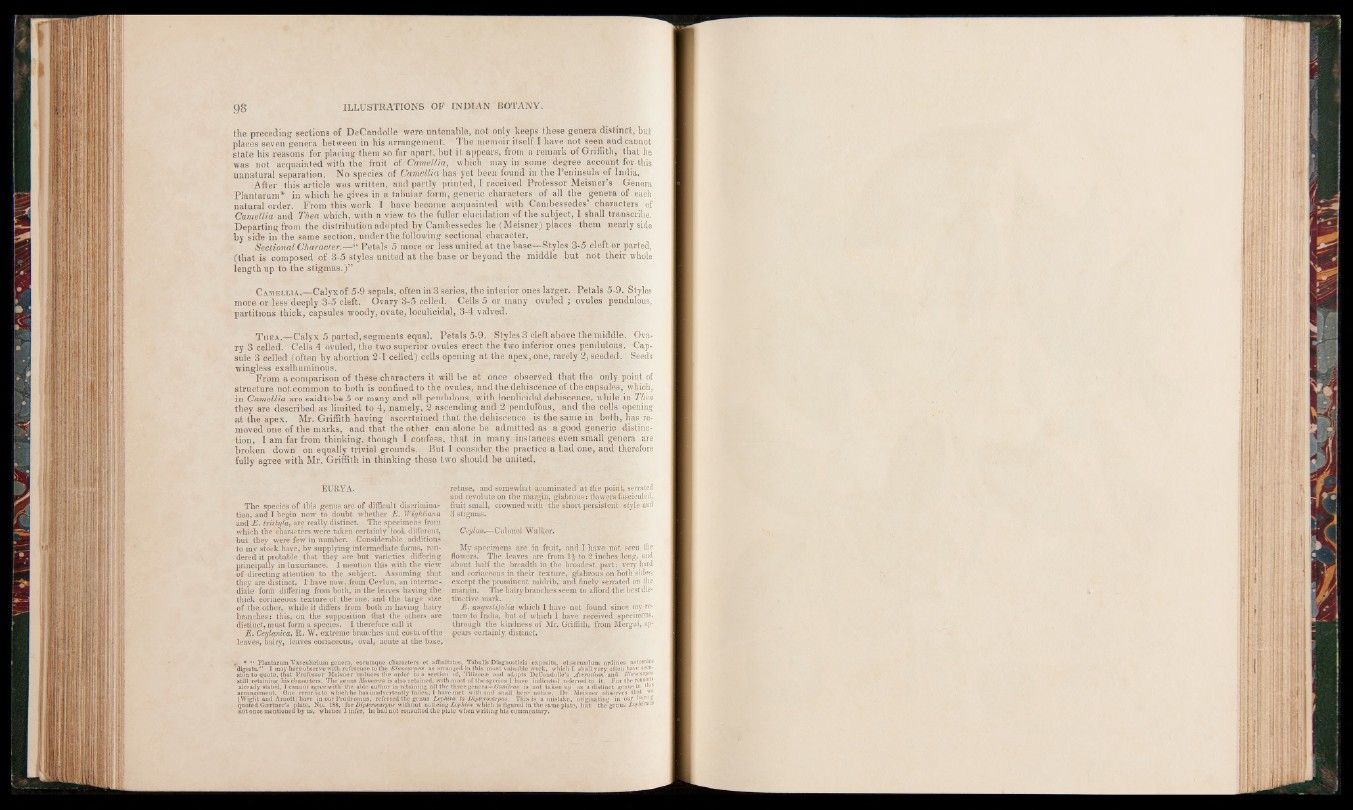
the preceding sections of DeCandolle were untenable, not only keeps these genera distinct, but
places seven genera between in his arrangement. The memoir itself I have not seen and cannot
state his reasons for placing them so far apart, but it appears, from a remark of Griffith, that he
•was not acquainted with the fruit of Camellia, which may in some degree account for this
unnatural separation. No species of Camellia has yet been found in the Peninsula of India.
After this article was written, and partly printed, I received Professor Meisner’s Genera
Plantarum* in which he gives in a tabular form, generic characters of all the genera of each
natural order. From this work I have become acquainted with Cambessedes’ characters of
Camellia and Thea which, with a view to the fuller elucidation of the subject, I shall transcribe.
Departing from the distribution adopted by Cambessedes he (Meisner) places them nearly side
by side in the same section, under the following sectional character.
Sectional Character.—“ Petals 5 more or less united at the base—Styles 3-5 cleft or parted,
(that is composed of 3-5 styles united at the base or beyond the middle but not their whole
length up to the stigmas.)”
C amellia.—Calyx of 5-9 sepals, often in 3 series, the interior ones larger. Petals 5-9. Styles
more, or less deeply 3-5 cleft. Ovary 3-5 celled. Cells 5 or many ovuled ; ovules pendulous,
partitions thick, capsules woody, ovate, loculicidal, 3-4 valved.
T hea.— Calyx 5 parted, segments equal. Petals 5-9. Styles 3 cleft above the middle. Ovary
3 celled. Cells 4 ovuled, the two superior ovules erect the two inferior ones pendulous. Capsule
3 celled (often by abortion 2-1 celled) cells opening at the apex, one, rarely 2, seeded. Seeds
wingless exalbuminous.
From a comparison of these-characters it^ will be at once observed that the only point of
structure not common to both is confined to the ovules, and the dehiscence of the capsules, which,
in Camellia are saidtobe 5 or many and all pendulous, with loculicidal dehiscence, while in Thea
they are described as limited to 4, namely, 2 ascending and 2 pendulous, and the cells opening
at the apex. Mr. Griffith having ascertained that the dehiscence is the same in both, has removed
one of the marks, and that the other can alone be admitted as a good generic distinction,
I am far from thinking, though I confess, that in many instances even small genera are
broken down on equally trivial grounds. But I consider the practice a bad one, and therefore
fully agree with Mr. Griffith in thinking these two should be united.
EURYA.
The species of this genus are of difficult discrimination,
and I begin now to doubt whether E. Wightiana
and E . tristyla, are really distinct. The specimens from
which the characters were taken certainly look different,
but they were few in number. Considerable additions
to my stock have, by supplying intermediate forms, rendered
it probable that they are but varieties differing
principally in luxuriance. I mention this with the view
of directing attention to the subject. Assuming that
they are distinct, I have now, from Ceylon, an intermediate
form differing from both, in the leaves having the
thick coriaceous texture of the one,' and the large size
of the, other, while it differs from both in having hairy
branches: this, on the supposition that the others are
distinct, must form a species. I therefore call it
E. Ceylanica, It. W. extreme branches and costa of the
leaves, hairy, leaves coriaceous, oval, acute at the base,
retuse, and somewhat acuminated at the point* serrated
and revolute on the margin, glabrous: flowers fasciculed,
fruit small, crowned with the short persistent - style and
3 stigmas.
Ceylon.—Colonel Walker.
My specimens are in fruit, and I have not seen the
flowers. The leaves are from 1£ to 2 inches long, and
about half the breadth in the broadest part; very hard
and coriaceous in their texture, glabrous on both sides,
except the prominent midrib, and finely serrated on the
margin. The hairy branches seem to afford the best distinctive
mark.
E . angustifolia which I have not found since my return
to India, but of which I have received^ specimens,
through the kindness of Mr. Griffith, from Mergui, appears
certainly distinct.
. * “ Plantarum Vascularium genera, coramque characters et affinitates, Tabulis Diagnostieis exposita, et secundum ordiries naturales
digesta.” I may here observe with reference to the EUBocarpcee as arranged in this most valuable work, which I shall very often have occasion
to quote, that Professor Meisner reduces the order to a section of, Tiliaceas and adopts DeCandolle’s AceratiwrC and EIteocar/nis
still retaining his characters. The genus Monocera is also retained, with most of the species I have indicated referred to it. For the reasons
already stated, I cannot agree with the able author in retaining all the three genera— Ganitrus is not taken tip as a distinct genus in this
arrangement. One error into which he has inadvertently fallen, I have met with and shall here notice. Dr. Meisner observes that we
(Wight and Arnott) have in our Prodromus, referred the genus Lophira to Dipteroearpui. This is a mistake, originating in our having
quoted Gasrtner’s plate, No. 188, for Dipterocarpus without noticing Lophira which is figured in the same plate, hut the genua Loi'^ra 25
not once mentioned by us, whence I infer, he had not consulted the plate when writing his commentary.